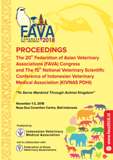PAT-5 Update: Q Fever in Indonesia
Abstract
Q Fever is zoonotic disease caused by Coxiella burnetii, an intracellular obligate and negative Gram bacterium with pleomorphic shape (Kaplan and Bertagna 1955). Centers for Disease Control and Prevention (CDC) classify Coxiella burnetii as potential bioterrorism agent within B rank for its ability and characteristics (CDC 2013).
The main reservoir animals for Q fever are ruminants (Maurin and Raoult 1999). Q fever infection whether in animal or human generally occur through inhalation, vector bites, or through oral ingestion—the last two routes are considered as secondary routes (Angelakis and Raoult 2010). Clinical symptoms of Q fever in both animal and human generally asymptomatic. Q fever can cause abortion in the third trimester of pregnancy and pneumonia in ruminants. Whether in human, acute Q fever can cause flu like syndrome and can develop into hepatitis, endocarditis, and for some severe chronic case, it caused death (Fournier et al. 1998).
Office international des epizooties (OIE) classify Q fever into a re-emerging disease group (OIE 2010). Based on OIE data in 2012, the distribution of Q fever in animals occur in almost all country in the world including ASEAN (OIE 2012).
Q fever was first discovered in Australia in 1935 (Kaplan and Bertagna 1955). Q fever disease transmission in animal occurs almost in every country in the world. Based on OIE data, Indonesia was classified as no information region (OIE 2012). World Health Organization (WHO) reported that Q fever was first found in cow serologically in Indonesia in 1953 (Kaplan and Bertagna 1955). Q fever in ruminants was again reported by Indonesian researcher between 2006 to 2015 in Bali, West Java, Jakarta, and Medan (Mahatmi et al. 2007; Setiyono et al. 2008; Nasution et al. 2015).
Positive Q fever result was obtained especially from ex imported cows, thus it was suspected that cows from abroad might play main role of transmission of Q fever in Indonesia. However, there was also report of positive result in local ruminants, such as Bali cattle, goat, and sheep (Mahatmi et al. 2007). Researches in various country also stated of potential local ruminant as reservoir animal, among them are Tibet sheep in China, Alpine and Saanen goat in Italia, camel (Camelus dromedaries) in Saudi Arabia, or Swedish dairy cattle in Swedia (Mohammed et al. 2014). Based on the historical study of Q fever in Indonesia, this research was performed by taken sample from both ex-import cattle and local ruminants in several region in East Java (Malang, Surabaya, Madura), Central Java (Boyolali), and West Java (Bogor, Bandung, Depok) which are known as regions with high population of ruminants in Indonesia. So far, surveillance data of Q fever has not been recorded from these regions.

